Microalgae-based ingredients are useful vegetarian sources of DHA n-3 for functional foods

By William Barclay, PhD, and Mary Van Elswyk, PhD, RD
Introduction
The n-3 fatty acid, docosahexaenoic acid, or DHA (22:6n-3) is one of the most unsaturated fatty acids available in our diet and is technically considered a "long-chain" (LC) n-3 fatty acid. Derived predominately from marine sources, DHA provides a broad range of health benefits including helping reduce the risk of cardiovascular disease and improving maternal and infant health. This discussion focuses on the important benefits of DHA and the usefulness of microalgae-based ingredients as vegetarian sources of DHA n-3 in fortified and enriched functional foods.
Functional Foods and DHA
Functional foods reflect a growing trend in the consumer goods industry and a convenient means for reintroducing DHA into the human diet. Functional food can be defined as any modified food or food ingredient that provides physiologically active nutrients that promote human health and reduce risk of disease (Angus et al., 2000) Epidemiological and clinical research suggests that as little as 200-650 mg long-chain n-3 fatty acids daily may be useful to promote good health. A reasonable target DHA dose, for a functional food as it relates to cost, consumer acceptance and benefit, is between 100-600 mg DHA. The target dose may be obtaining either through multiple food product servings or from a variety of DHA enriched and fortified food products.
DHA Natural Enrichment and Fortification Options
Production of DHA-rich functional foods can be accomplished by at least two routes. For the purposes of this discussion natural enrichment refers to the addition of target nutrients to the diets of production animals for the enrichment of their resulting products (e.g. eggs, milk, meat). The other method of developing a functional food relies on fortification or the addition of a nutrient directly to a processed food. Each method has benefits and desirable characteristics. DHA-rich foods can be developed via either approach using OmegaTech's patented fermentation technology to derive DHA-rich oil and DHA-rich microalgae. This technology, which has been developed completely without the use of genetic engineering, relies on a strain of microalgae, Schizochytrium sp., which contains 50-85% lipid and over 20% DHA on a dry weight basis. The resulting fermentation product, dried whole-cell DHA-rich microalgae (DHA GOLD®), can be added directly to the feed of poultry and other animals to naturally restore DHA to our existing food supply (eggs, milk, and meat). DHA GOLD is a 100% vegetarian source of DHA representing the original source of DHA in the food chain – where fish get their DHA!
Products naturally enriched with DHA GOLD microalgae are available throughout the world. In the U.S. DHA-rich eggs have been marketed under the Gold Circle Farms brand since 1998. Table 1 outlines the difference in fatty acid composition in these eggs compared to regular market eggs.
Table 1. Content of key nutrients in DHA-enriched eggs (Gold Circle Farms) compared to regular market eggs. The DHA-enriched eggs were produced by adding DHA-rich microalgae (DHA GOLD) to the feed of laying hens.
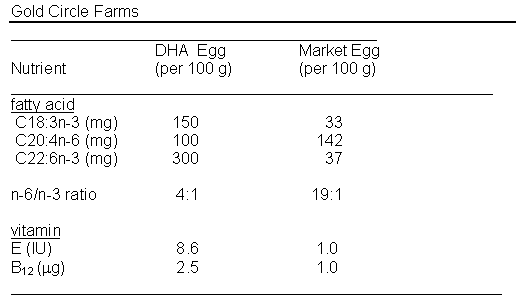
In Germany DHA-rich eggs, enriched from DHA GOLD microalgae were recently awarded an endorsement from the German Heart Association, have been marketed under the OmegaDHA brand since 1996. These DHA-enriched eggs, in association with similar products in Norway and Belgium, garnered the recognition of the prestigious Food Ingredients Europe group and were awarded the Most Innovative Finished Food Product Award for 1996/1997.
Research on the production of DHA-enriched pork using natural enrichment has been conducted in Italy. Additionally, efforts to enrich rabbit meat and dairy products (cattle & goat) are underway. DHA content of enriched meat products is outlined in Table 2. Products targeted for DHA enrichment are those that will reach the broadest populations in the most convenient manner. Dairy products provide strong opportunity, as they are both ingredients and "staple" foods.
Table 2. DHA and long chain n-3 fatty acid content of DHA-enriched pork meat and pork products made from the enriched meat. DHA-enriched pork was produced by adding DHA-rich microalgae (DHA GOLD) to the feed of swine.
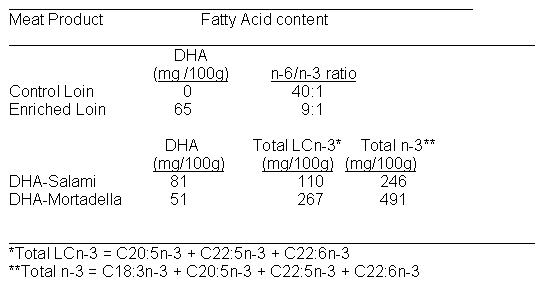
Direct fortification can be accomplished by using DHA GOLD oil. This oil is obtained from the microalgae and can be used directly as oil, or in an emulsified or microencapsulated form to fortify foods. Alternatively, the microalgae, which contains the oil, is naturally encapsulated within the microalgae. When appropriately stabilized, microalgae can be used directly as an ingredient. The DHA content of this oil is about 40% of total fatty acids and the microalgae contains about 20% of dry weight microalgae.
Dairy products such as milk, yogurt, cheese, and frozen dairy products like whipped toppings and ice cream; provide an excellent opportunity to introduce DHA-rich functional foods. Other food categories also make sensible functional food targets. In February of 2000, TNUVA, the largest dairy group in Israel launched a DHA-fortified soft cheese using DHA GOLD oil as an ingredient. The resulting product, Balance, has obtained widespread retail distribution and attention by both healthcare professionals and the Israeli news media. Table 3 outlines many of the potential ingredient options provided by use of this microalgal-based technology.
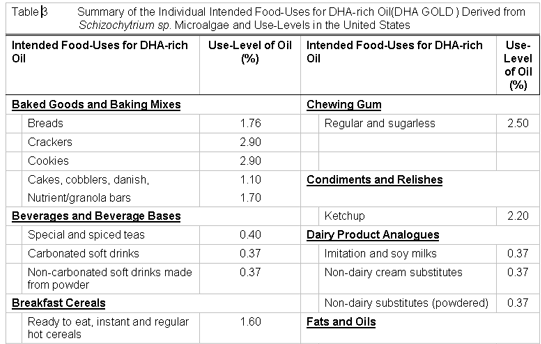
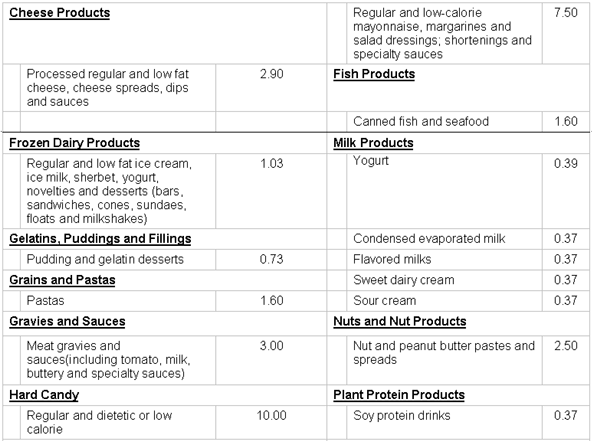
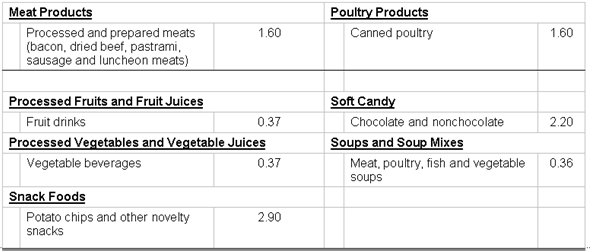
DHA and Human Health
The role of long-chain n-3 fatty acids in the reduction of cardiac arrhythmia, the precursor of sudden cardiac death, has been recently recognized. The results of the Multiple Risk Factor Intervention Trial (MRFIT; Siscovick et al., 1995), the Physician's Health Study (Albert et al., 1998) and the GISSI-Prevenzione Trial (Valagussa, 1999) noted that sudden cardiac death was reduced by 20-40% among persons consuming DHA and EPA. Daily consumption of as little as 200-250 mg DHA/EPA was enough to bring about these positive benefits for otherwise healthy individuals in the MRFIT and Physicians Health studies. Valagussa et al. (1999) clarified the therapuetic dose as 900-mg DHA/EPA in patients with previous myocardial infarction. The above reports confirm data in lab animals suggesting that DHA can stabilize heart muscle and make it resistant to stimulus of irregular heartbeat (Kang and Leaf, 1996).
Another beneficial aspect of consuming long-chain DHA and EPA n-3 fatty acids for cardiac health is in the reduction of plasma triglycerides. In the past decade alone over 130 studies have been conducted exploring the hypotriglyceridemic effect of long-chain n-3 fatty acids and over 80% have proven efficacious. In individuals with normal blood lipids an average reduction in triglcyerides of 26% has been noted while an average of 32% triglyceride reduction was noted in individuals with elevated triglycerides. Interestingly, these reductions can be achieved with as little as 1 g of long-chain n-3 daily.
Other unique and important health benefits of dietary DHA fall in the area of maternal health. A recent study of DHA supplementation of pregnant women using DHA-enriched eggs from hens fed DHA GOLD indicates beneficial pregnancy outcomes. Women who consumed 205 mg of DHA from enriched eggs daily during the third trimester had fewer low-birth weight (0% vs. 26%) and preterm (6% vs. 26%) births than women who ate ordinary eggs (Borod et al., 1999). This study was small and preliminary without statistically relevant numbers to detect the effect of DHA on pregnancy outcome. A larger, adequately powered clinical trial further testing the hypothesis that DHA from DHA GOLD enriched eggs may improve pregnancy outcomes is ongoing.
DHA has also been identified as a vital nutrient for neurological development and function. For example, cognitive and visual complications associated with preterm delivery are reduced with DHA inclusion into the maternal diet. The third trimester of pregnancy is the period of greatest DHA accumulation by the fetus (Green, 1998). Dietary supplementation with DHA has been hypothesized to compensate for the deprivation of DHA that preterm infants suffer (Hoffman et al., 1993; Carlson and Werkman, 1996).
Enrichment of dairy products with DHA also makes physiological sense as research suggests that long chain n-3 fatty acids may promote bone health (Watkins, 1998; Watkins et al., 2000) and consumers typically look to dairy products for healthy bones. Finally, a recent study reports that part-skim milk directly fortified with 300 mg long-chain n-3 fatty acids significantly reduced plasma triglyceride and increased HDL levels among normolipidemic consumers in a 6-week trial (Visioli et al., 2000).
Complementary and Synergistic Ingredients
Given the oil soluble nature of DHA GOLD oil, the opportunity to combine this ingredient with other like natured functional ingredients for synergy or enhanced delivery should be considered. These ingredients include phytosterols, caroteniods, antioxidants, vitamins and other fatty acids. Additionally, dry product delivery forms of these ingredients may be blended or processed with the dry microalgae.
The attractive and flexible properties and characteristics of DHA GOLD oil and DHA GOLD microalgae along with its wide variety of applications make this technology an effective way to enhance DHA availability in our food chain. This technology allows for both the natural enrichment of animal products and the direct fortification of further processed foods. Using these techniques DHA GOLD represents a unique opportunity to deliver DHA into a wide variety of functional and therapeutic food applications.
References
Albert, C., Hennekens, C., O'Donnell, C., Ajani, U., Carey, V., Willett, W., Ruskin, J., and Manson, J. 1998. Fish consumption and risk of sudden cardiac death. Journal of the American Medical Association, 279:23-28.
Angus F, Miller C, editors. Natural Enrichment of Foods with DHA Omega-3 from Marine Algae. Proceedings of the Functional Foods 2000 Conference; 2000 Feb 29; The Hague, Netherlands: Leatherhead Publishing 2000.
Borod, E., Atkinson, R., Barclay, W.R., and Carlson, S.E. 1999. Effects of third trimester consumption of eggs high in docosahexaenoic acid on docosahexaenoic acid status and pregnancy. Lipids, 34:S231.
Carlson, S. and Werkman, S. 1996. A randomized trial of visual attention of preterm infants fed docosahexaenoic acid until two months. Lipids, 31:85-90.
Green, P. and Yavin, E. 1998. Mechanisms of docosahexaenoic acid accretion in the fetal brain. Journal of Neuroscience Research, 52:129-136.
Hoffman, D., Birch, E., Birch, D., and Uauy, R. 1993. Effects of supplementation with n-3long-chain polyunsaturated fatty acids on retinal and cortical development in premature infants. American Journal of Clinical Nutrition, 57:807S-12S.
Kang, J. and Leaf, A. 1996. The cardiac antiarrhythmic effects of polyunsaturated fatty acid. Lipids, 31:S41-S44.
Siscovick et al., 1995. Dietary intake and cell membrane levels of long-chain n-3 polyunsaturated fatty acids and the risk of primary cardiac arrest. Journal of the American Medical Association, 274:1363-1367.
Valagussa et al. 1999. Dietary supplementation with n-3 polyunsaturated fatty acids and vitamin E after myocardial infarction: results of the GISSI-Prevenzione trial. Lancet, 354:447-55.
Visioli, F. et al, 2000. Very low intakes of N-3 fatty acids incorporated into bovine milk reduce plasma triacylglycerol and increase HDL-cholesterol concentrations in healthy subjects. Pharmacol Res, 41:571-576.
Watkins, B.A., 1998. Regulatory effects of polyunsaturates on bone modeling and cartilage function. Simopoulous AP (ed): The Return of Omega-3 Fatty Acids into the Food Supply. I. Land-Based Animal Food Products and Their Health Effects. World Rev Nutr Diet. Basel, Karger, 83:38-51.
Watkins, B.A., et al, 2000. Dietary ratio of (n-6)/(n-3) polyunsaturated fatty acids alters the fatty acid composition of bone compartments and biomarkers of bone formation in rats. J Nutr, 130:2274-2284.
Source: OmegaTech, Inc
